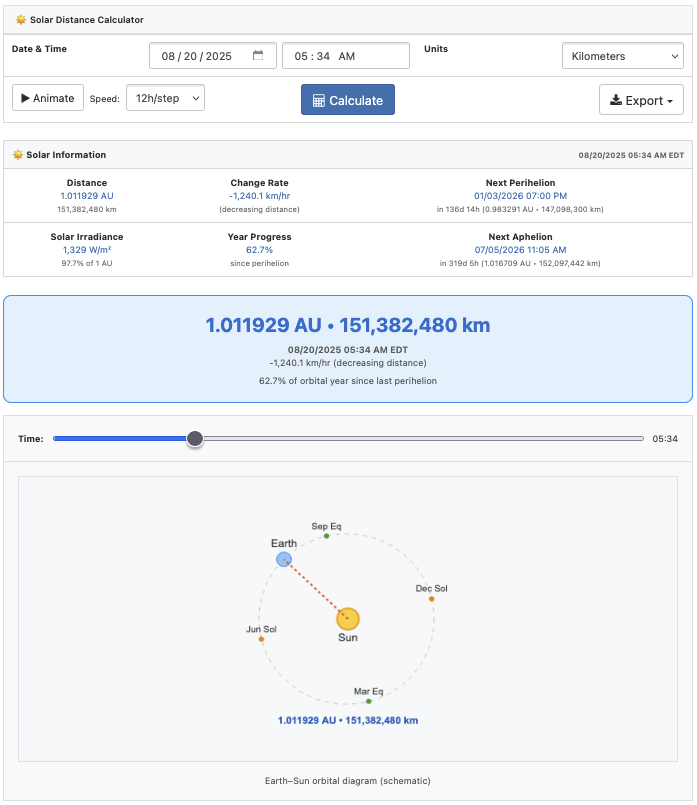Track Earth's distance from the Sun in real-time with our interactive solar distance calculator. See live distance updates in miles, kilometers, and astronomical units, with an animated orbital diagram showing how far away the Sun is at your choice of date and time.
The Sun is 91.4 million miles (147.1 million km, 0.983361 AU) from Earth as of December 30, 2025 1:08 AM UTC.
Solar distance calculator
Times are shown in your local timezone.
Using the solar distance calculator
The calculator shows Earth's current distance from the Sun, updating in real-time as you change the date and time. Drag the time slider to see how our distance changes throughout the day and year. Hit the Animate button to watch Earth's orbital journey at various speeds.
Real-time distance tracking
- Current Distance: Live solar distance displayed in astronomical units (AU), with kilometers and miles for reference
- Distance Rate: How fast Earth is moving toward or away from the Sun during its elliptical orbit
- Next Perihelion/Aphelion: Countdown to Earth's next closest and farthest approach with exact dates and distances
- Solar Irradiance: Solar energy reaching Earth's atmosphere
- Year Progress: How far through Earth's orbital year since our last closest approach (perihelion)
Earth's distance from the Sun varies more than most realize; we're about 3.1 million miles closer to the sun in January than July. This variation affects everything from solar panel efficiency to the precise timing of sunrise and sunset throughout the year.
Seasons aren’t caused by how far we are from the Sun, but by Earth’s axial tilt (~23.5°). Distance mainly changes the Sun’s apparent size and the top‑of‑atmosphere irradiance – there's about a 7% swing between perihelion and aphelion. As you size, you shouldn't be staring at the sun, anyway.
Interactive orbital visualization
The orbital diagram shows Earth's elliptical path around the Sun in real-time:
- Elliptical Orbit Model: Shows Earth's elliptical path around the Sun
- Current Position: Earth's location on the orbit updates live as you change date and time - to see the sun's position relative to Earth, try our day/night map or solar tracker map
- Distance Visualization: A connecting line shows the current Earth-Sun distance with measurements
- Seasonal Markers: Solstices and equinoxes marked on the orbit (see here)
- Animation Controls: Watch a full year of Earth's orbit in seconds with speed controls from 1 hour to 7 days per step

The calculator also detects when Earth reaches its closest and farthest points from the Sun:
- Perihelion (Closest): Occurs around January 4th each year with the Earth at approximately 147 million kilometers from the Sun (91.4 million miles, 0.983 AU)
- Aphelion (Farthest): Happens around July 4th with the Earth at about 152 million kilometers from the Sun (94.5 million miles, 1.017 AU)
- Solar Energy Variation: Earth receives about 7% more solar energy in January than July due to the distance
Export and data features
- CSV Export: Download monthly solar distance data for the entire year with precise AU, kilometer, and mile measurements
- SVG Diagram Export: Save the current orbital diagram as a SVG for presentations or reports, your phone’s lock screen, or to frame and hang on your wall
- Multiple Units: All distances shown in astronomical units (AU), plus kilometers and miles for reference
- Precise Timing: Calculations accurate to within hours for perihelion/aphelion events
Calculation accuracy and methodology
The calculator uses precise orbital mechanics based on Kepler's laws of planetary motion. The core equation is Kepler's equation:
M = E - e \sin(E)
Where M is the mean anomaly, E is the eccentric anomaly, and e is Earth's orbital eccentricity (0.0167086). The equation is solved using the Newton–Raphson method with iterations until convergence.
Earth's distance r at any time is then calculated using:
r = a(1 - e \cos(E))
Where a is the semi-major axis (1 AU = 149,597,870.7 km).
Top‑of‑atmosphere solar irradiance follows the inverse‑square law: I = S0·(a/r)2, where S0 ≈ 1361 W/m2 at 1 AU. See inverse‑square law and Kopp & Lean (2011).
- Orbital parameters: Uses NASA planetary fact sheet values for Earth's semi-major axis, eccentricity, and sidereal year
- Perihelion/Aphelion timing: Accurate to within hours using iterative refinement algorithms scanning orbital extrema
- Solar irradiance: Calculated using the inverse square law with the solar constant (1361 W/m² at 1 AU)
For critical astronomical calculations, verify against data from NASA JPL Horizons. This tool provides educational accuracy suitable for getting started with most applications. It's not suitable for navigation or precise scientific research.
Related solar and astronomy tools
Explore more solar and astronomical calculations with these related tools:
- Lunar Distance Calculator - See Earth's distance from the Moon
- Sun Angle Calculator - Hour by hour solar position and shadow lengths
- Solar Panel Angle Calculator - Optimize panel tilt for maximum energy
- Sunrise Sunset Calculator - Sun timing and golden hour tracker
- Solar Tracker Map - Real-time sun position visualization
- Analemma Calculator - Track the sun's figure-8 pattern
- Sun Path Diagram Generator - Visualize solar movement by location
- Solar Noon Calculator - Find when the sun peaks
- Moon Phase Calculator - Complete lunar cycle tracking
- Day Night World Map - Global daylight patterns in real-time
- Daylight Hours Graph - Annual daylight variation chart
- Twilight Calculator - Civil, nautical, and astronomical twilight
